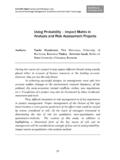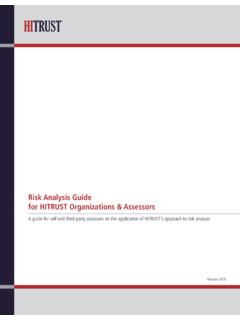Transcription of Age restrictions for rotavirus vaccination: evidence …
1 Benefit-risk rotavirus_ver 1 age restrictions for rotavirus vaccination : evidence -based analysis of rotavirus mortality reduction versus risk of fatal intussusception by mortality stratum Benefit-risk rotavirus_ver 2 SUMMARY Background: To minimize potential risk of intussusception, the World Health Organization (WHO) recommends that rotavirus immunization should be intiated by age 15 weeks and completed before age 32 weeks. A large body of evidence now exists on the burden of fatal rotavirus disease and the safety and efficacy of rotavirus vaccines compared to the previous similar analysis done in 2009.
2 These data were applied to assess and compare the potential benefits for mortality reduction from rotavirus versus the risk of fatal intussusception for an age restricted and unrestricted vaccination policy in WHO countries with low and high child mortality. Methods: This analysis modeled the number of rotavirus deaths prevented by rotavirus vaccination and the number of intussusception deaths caused by vaccination when administered on the current restricted schedule versus an unrestricted schedule whereby rotavirus vaccine would be administered with DTP vaccine up to age 3 years.
3 Countries were grouped by WHO child mortality strata. Inputs were stratum-specific estimates of rotavirus mortality, intussusception mortality, and predicted vaccination rates by week of age, and vaccine efficacy and vaccine-associated intussusception risk. Findings: The model estimated that a restricted schedule would prevent 156,100 rotavirus deaths (5th 95th centiles, 110,100 201,800) while causing 288 intussusception deaths (99 688). Vaccination without age restrictions would prevent 199,200 rotavirus deaths (140,700 255,400) while causing 605 intussusception deaths (310 1,133).
4 Without the age restrictions vaccination would avert an additional 136 rotavirus deaths for every intussusception death caused by vaccine, for a net benefit of 42,800 additional deaths (30,400 53,200) prevented by vaccination. These additional deaths prevented under an unrestricted verus restricted schedule reflect an additional 21%-25% children who would potentially be eligible for rotavirus vaccine. The number of additional rotavirus deaths averted and intussusception deaths cuased by vaccination varied by WHO mortality are as follows: -B& C countries: 3,900 (3,600-4,000 versus 20 (11-30); Benefit-risk rotavirus_ver 3 -D-Americas: 500 (300-600) versus 2 (1-3).)
5 -D-Asia: 20,100 (13,000-25,900) versus 169 (106-243) -D&E-Africa: 18,400 (13,800-22,600) versus 125 (91-170) Interpretation: In low and middle-income countries, the additional lives saved by removing age restrictions for rotavirus vaccination would outnumber the excess vaccine-associated intussusception deaths. Benefit-risk rotavirus_ver 4 BACKGROUND rotavirus infection is the leading cause of fatal diarrhea among children younger than 5 years, accounting for 453,000 deaths in the year 2008 based on recently published World Health Organization (WHO) To curb this large toll of severe rotavirus disease, in 2006, the WHO recommended two rotavirus vaccines Rotarix (GSK Biologicals) and Rotateq (Merck & Co.)
6 For use in Europe and the Americas, and in 2009, they expanded this recommendation to all children These recommendations reflected the sequential availability of evidence of the good efficacy profile of rotavirus vaccines first from clinical trials in high and middle income countries in the Americas and Europe in 2006 and then also from low income settings in Africa and Asia in Furthermore, because a previous rotavirus vaccine (RotaShield) was found to be associated with intussusception, a rare form of bowel obstruction,8 the pivotal pre-licensure trials in the Americas and Europe for both rotavirus vaccine were conducted in over 60,000 infants each and did not document an increase in vaccine-associated.
7 4 Decision-makers worldwide have acted on these data and donor funding has also been made available for the poorest countries with the highest rotavirus mortality to purchase these Remarkable progress has been realized in the past 5 years with some 30 high and middle income countries having introduced a rotavirus vaccine into their national immunisation program and many have already documented substantial declines in severe and fatal diarrheal disease as a result of Recent data on the postlicensure safety of rotavirus vaccines generated from these countries has also shown evidence of a low level risk of intussusception (~1-2 excess cases per 100,000 vaccinated infants)
8 In some countries but not in , 15 Based on considerations that this low level risk is greatly exceeded by the observed health benefits of vaccination, national and international policy and regulatory bodies have continued to support recommendations for use of rotavirus , 15 Benefit-risk rotavirus_ver 5 WHO currently recommends that rotavirus vaccines should not be initiated for infants aged 15 weeks or older, with all doses being completed by 32 These age restrictions are driven by concerns about intussusception risk. Natural intussusception rarely occurs before 3 months of age and the incidence increases 10-fold between 3 and 6 months of age.
9 16 Therefore, any potential vaccine-associated risk of intussusception, particularly with the first vaccine dose that has been primarily associated with risk, would translate to more excess cases if infants were vaccinated late, beyond 3 months of age. Similar findings were observed in the United States after use of RotaShield, prompting a debate of whether restriction of RotaShield to infants younger than 3 months of age would have averted withdrawal of the A consequence of these strict restrictions is that those arriving late for immunisation would potentially not have access to the benefits of rotavirus This is particularly relevant for the developing world, where substantial delays in the timing of childhood vaccination occur in many Previously.
10 A scenario analysis assessed the benefits and risks of a rotavirus vaccination strategy with and without an age Since this analysis , new evidence has been published on several key parameters for the scenario analysis , including data on efficacy of rotavirus vaccines in Africa and Asia,6, 7 the effect of rotavirus vaccines on diarrhea deaths,11, 12 postlicensure data on risk of intussusception with current rotavirus vaccines,14, 15, 24 the release of updated estimates of rotavirus mortality by WHO1, age-distribution of rotavirus disease by week of age, and updated data on timeliess of vaccination coverage in low and middle income countries.














